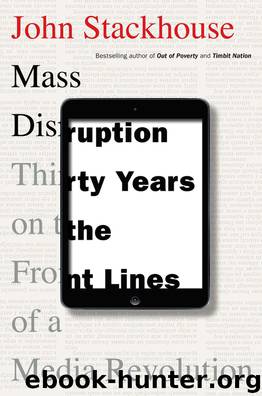Mass Disruption: Thirty Years on the Front Lines of a Media Revolution by John Stackhouse

Author:John Stackhouse [Stackhouse, John]
Language: eng
Format: epub
Publisher: Random House Canada
Published: 2015-10-26T16:00:00+00:00
CHAPTER 11
The Price of Journalism
BY 2012, THE NEWSPAPER WORLD was deeply divided, between the free camp and the pay camp. The former held firmly to the view that consumers, especially younger ones, would not pay for anything but the scarcest of goods on the Internet. And news was not scarce. This view wasn’t rooted in social habits alone. Many in the free camp believed news was a social service, and had to be free. The only reason newspapers had ever been priced, the argument went, was to cover the cost of paper, ink and delivery. Advertising had always paid for the journalism, and would continue to do so in the digital age. The pay camp had given up any hope of that happening. For all the advertising generated by Google, publishers were not covering their bills with digital revenue. Many weren’t even sure the new readers they had gained through Google, Facebook and free access to their own sites were worth it. Digital loyalty was about as cheap as an online ad. There had to be a way, the pay camp felt, to build a more reliable base of revenue, and restore a semblance of reader loyalty. Charging for news was their ticket.
As the media world limped out of the financial crisis and into a new decade of anxiety, the idea of paid content—any content—was starting to gain acceptance. PayPal and iTunes had led a small revolution in payment technology, and e-commerce had become normal. Music, movies and books were all shifting, albeit slowly and fitfully, to pay models. Why not news? Led by the New York Times, about 20 percent of American papers were in the process of launching paywalls, the term used for digital subscriptions. That number would quickly rise to 50 percent. Some of the world’s most competitive news markets were following suit. Many of Germany’s newspapers had moved to digital subscriptions. In Britain, the Telegraph and the Times were set to launch online subscriptions, while the Guardian and others were building paid apps to run alongside their free websites.
Of course, the most successful paywalls already in place were in financial media. Readers could see a monetary value in market-moving journalism and were well positioned to pay for a subscription (or expense it to their company). The big ones—the Financial Times and Wall Street Journal—had a large print base to draw on, too. The FT had built its paying digital audience to about 300,000, while scaling back its print circulation to a mere 75,000 in the United Kingdom. To help engineer the transition, the publication had jacked up print prices—doubling them in eighteen months—which also sent a positive message to its journalists, to produce superior content.
Canadian newspapers seemed more cautious. A couple of niche publications had tried to forge the way. AllNovaScotia, a site launched in 2001 by Fleet Street veteran David Bentley, had developed an impressive base of subscribers in that province by focusing on provincial news and politics. No pictures, videos, graphics or reader forums. Just text.
Download
This site does not store any files on its server. We only index and link to content provided by other sites. Please contact the content providers to delete copyright contents if any and email us, we'll remove relevant links or contents immediately.
Hit Refresh by Satya Nadella(9013)
When Breath Becomes Air by Paul Kalanithi(8292)
The Girl Without a Voice by Casey Watson(7801)
A Court of Wings and Ruin by Sarah J. Maas(7616)
Do No Harm Stories of Life, Death and Brain Surgery by Henry Marsh(6874)
Shoe Dog by Phil Knight(5104)
Hunger by Roxane Gay(4854)
The Rules Do Not Apply by Ariel Levy(4820)
A Higher Loyalty: Truth, Lies, and Leadership by James Comey(4820)
Tuesdays with Morrie by Mitch Albom(4658)
Everything Happens for a Reason by Kate Bowler(4656)
The Immortal Life of Henrietta Lacks by Rebecca Skloot(4498)
Millionaire: The Philanderer, Gambler, and Duelist Who Invented Modern Finance by Janet Gleeson(4350)
How to Change Your Mind by Michael Pollan(4273)
All Creatures Great and Small by James Herriot(4211)
Man and His Symbols by Carl Gustav Jung(4052)
The Money Culture by Michael Lewis(4050)
Elon Musk by Ashlee Vance(4007)
Tokyo Vice: An American Reporter on the Police Beat in Japan by Jake Adelstein(3922)
